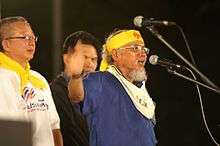New Politics Party
The New Politics Party (abbreviated NPP; Thai: พรรคการเมืองใหม่ RTGS: Phak Kan Mueang Mai, ก.ม.ม.), was a political party in Thailand founded on 2 June 2009. The NPP was the political party of the People's Alliance for Democracy (PAD; "Yellow Shirts"), with which it shared the same principles and ideas.[1] Ahead of the 2011 general election, the party broke with the PAD movement, and renamed to Thai Social Democratic Party (TSDP; Thai: พรรคสังคมประชาธิปไตยไทย) two years later.
New Politics Party พรรคการเมืองใหม่ | |
|---|---|
| Abbreviation | NPP |
| Leader | Sonthi Limthongkul (2009–2010) Somsak Kosaisuuk (2010–2013) |
| Secretary-General | Sukom Srinuan |
| Spokesperson | Chalong Raksasri |
| Founded | 2 June 2009 |
| Dissolved | 7 July 2013 |
| Headquarters | Bangkok, Thailand |
History

In May 2009, The People's Alliance for Democracy, better known as the "Yellow Shirts" movement, announced to create a political party. It claimed that other political parties in Thailand protected only their own vested interests, such as the bureaucrats and elites, and were unable to tackle the country's problems. The party aspired to solicit more than 5,000 members and set up branches in all regions of Thailand, within the one-year deadline. It also planned to an early completion of the registration process in order to contest the next general election. The interim leader of the party was Somsak Kosaisuuk. On 7 October 2009, Sondhi Limthongkul was elected as the leader of the party.[2]
The party's colors were yellow and green. Yellow referred to the constitutional monarchy of Thailand, and green represented "clean politics", in which corruption is repelled by an independent judiciary. The party's logo showed four yellow hands intertwined in a swastika-like arrangement, against a green background, topped by a rainbow in Thailand's national colours. It was said to symbolise that "the people are at the centre of new politics", referring to the four main regions of Thailand and four occupational groups.[3][4]
Aims for political reform
PAD and NPP wanted to replace the National Assembly of Thailand with a body with only 30 percent directly elected members of parliament, the rest installed by employers and labour unions or similar interest groups, in order to achieve their ideal of "clean politics".[5] Their adherents typically distrusted established politicians and representatives and wanted to replace them.[6] The party claimed to defend the supposedly endangered monarchy.
2011 split
In 2011 a split occurred between Sondhi and the majority of PAD on one side and the NPP leadership around Somsak on the other. In late-March Sondhi demanded the party boycott the upcoming parliamentary elections according to PAD's extra-parliamentary opposition strategy and its abstention campaign ("Vote No"). This was rejected by Somsak and NPP functionaries who were keen to field candidates and seek parliamentary representation. The hardline PAD position, however, was that all party politicians—including NPP members—should retreat for a certain period while the king would appoint a non-partisan, expert government. This idea was rejected by Somsak and his public servants union, SELRC, as undemocratic and "close to a coup d'etat".[7] This led consequently to the retirement of Somsak from the PAD leadership in late-April and Sondhi's departure from the NPP in return. Eventually, the party received 0.1% of votes in the July 2011 election.[8]
In 2013 Somsak Kosaisuuk changed the name of the party to Thai Social Democratic Party.[9] The party won 0.02% of votes in the 2019 general election.
Leader
| No. | Name | From | To |
|---|---|---|---|
| 1 | Somsak Kosaisuk | 2 June 2009 | 5 October 2009[10] |
| 2 | Sonthi Limthongkul | 5 October 2009 | 14 May 2010[11] |
| 3 | Somsak Kosaisuk | 3 July 2010 | 7 July 2013 |
References
- Anucha Charoenpo (3 June 2009). "PAD names Somsak as party head". Bangkok Post. Retrieved 30 March 2019.
- The Nation, Sondhi elected as new leader Archived 4 October 2012 at the Wayback Machine, 7 October 2009
- Gerald W. Fry; Gayla S. Nieminen; Harold E. Smith, eds. (2013). Historical Dictionary of Thailand (Third ed.). Scarecrow Press. p. 274.
- Michael H. Nelson (2010). Marc Askew (ed.). Thailand's People's Alliance for Democracy: From "New Politics" to "Real" Political Party?. Legitimacy Crisis in Thailand. Silkworm Books. p. 134.
- Richard Lloyd Parry. "People's Alliance for Democracy's narrow nationalism in Thailand", The Times online, September 5, 2008, retrieved 5 January 2011.
- Mithran Somasundrum. "Shuffling towards fascism", The Guardian 3 September 2008, retrieved on January 5, 2011
- Bangkok Post, "Somsak Vetoes PAD Demand", 29 April 2011
- Election Commission of Thailand
- "สมศักดิ์" ลั่นตั้ง "ส.ป.ท." ปลดแอก "พธม." - ลาขาด "สนธิ-ยะใส", 7 July 2013
- "ตั้งพรรคการเมืองใหม่ สมศักดิ์รั้งห้วหน้า". Bangkok Biz News (in Thai). Archived from the original on 19 November 2011. Retrieved 30 March 2019.
- "พรรคการเมืองใหม่ ได้ก.ก.บริหารฯครบแล้ว "สนธิ" นั่งหัวหน้าพรรค" (in Thai). Retrieved 30 March 2019.